How to make an induction heating boiler with your own hands: making a homemade heat generator
People are spoiled by civilization and cannot imagine existing without its benefits. These undoubtedly include heating of buildings.Heating systems are constantly being improved and are becoming more efficient and convenient to use.
But this is not enough. Agree, it’s not bad at all if heating equipment is also economical. And this desire is quite feasible - you can make an induction heating boiler with your own hands. It is capable of not only providing the required level of heating of the room, but also very economically using energy resources.
Moreover, even a novice master can assemble such equipment if desired. How to do this correctly and what materials will be needed for manufacturing - we will examine these questions in detail in our article. Let us first consider the design and operating principle of the equipment, as well as the advantages of its use.
The content of the article:
Design and principle of operation of the equipment
Before you start assembling an induction boiler yourself, you need to understand its structure and operating principle. And only after understanding these points can you start making homemade products.
How does an induction boiler work?
To understand how induction equipment works, you need to become familiar with the principle of its operation. So let’s remember the school physics course.
When electrical current passes through a conductive material, it generates heat. In this case, the amount of heat received will be directly proportional to the voltage and current.This pattern was discovered by Joule and Lenz, after whom the physical law is named.
But electric current can appear in a conductor not only when it is directly connected to a power source. There is another method, discovered in the century before last by M. Faraday. This is a non-contact method that does not involve interaction between the power source and the conductor.
Its essence lies in the fact that when the parameters of the magnetic field that crosses the conductor change, an emf or electromotive force appears in it.
This phenomenon was called electromagnetic induction. This is what is used in the operation of the induction boiler. It turns out that if there is an EMF, then there will be an electric current, and accordingly, there will be heating of the conductor.
In this case, it will be produced in a contactless manner, using induced currents or, as they are also called, Foucault currents.
Electromagnetic induction can be obtained in two ways.In the first case, to obtain induction, a conductor is rotated or moved within a constant magnetic field. This method is used in electric generators.
Another way to obtain induction is that the conductor remains stationary, while the parameters of the magnetic field in which it is located, namely the direction of the field lines and intensity, are constantly changing.
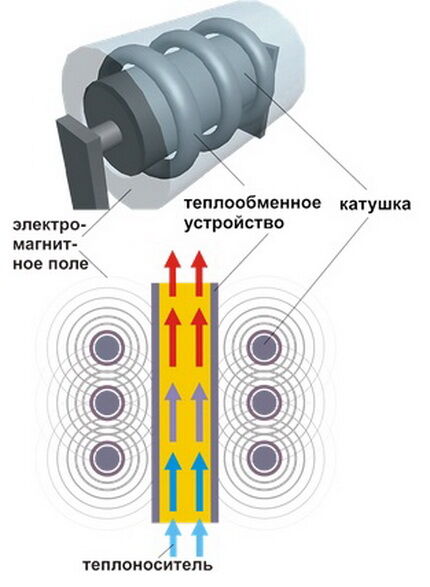
This would have been quite difficult to do if not for Oersted’s discovery. He found out that if a wire is wound around a coil, then when a power source is connected, it turns into an electromagnet. When the direction and strength of the current changes, the magnetic field that this device generates will also change.
If a conductor is placed inside the field, an electric current will arise in it, which is accompanied by heating.
It is on this principle that an induction boiler is designed. Its design is very simple. It includes a housing, which must be thermally insulated and shielded. A pipe is placed inside it. It is best if it is an alloy, but steel can also be used.
However, in the latter case, the performance characteristics of the device will suffer slightly. The pipe is installed in a sleeve made of dielectric material.
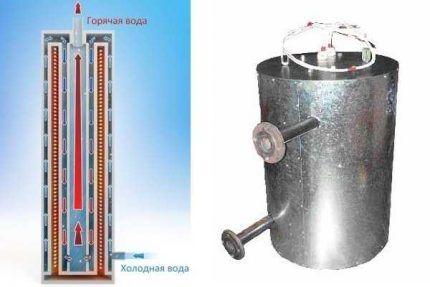
A copper busbar is wound on top of the sleeve using the coil principle. It is connected to a power source. To tie into the heating system, two pipes are used through which the coolant will move.
When power is applied, current flows through the coil and activates an alternating magnetic field, which in turn induces eddy currents inside the pipe. They heat the walls of the part, and partially the coolant that is located in it.
There are variations of the induction boiler with several small diameter tubes installed in parallel. They are used instead of one large pipe. This gives a gain in the speed of heating the device.
In this form, the equipment can already work, but the heating will be weak. To amplify it, you need to pass a high-frequency electric current through the coil. Therefore, the equipment must be supplemented with an inverter and rectifier.
The alternating current from the network has a frequency of 50 Hz, which is not enough for the induction boiler to operate efficiently. Therefore, it is supplied to the rectifier, where it is converted into a constant one.
After which it is sent to the inverter, which is an electronic module with a control circuit and two key transistors. The device converts direct current into high frequency.
It must be admitted that the use of a rectifier and inverter increases the cost of an induction boiler. Therefore, there are models that work without them. They connect to a regular network. But such equipment has impressive dimensions, which makes it possible to increase its efficiency. Devices with an inverter are more compact.
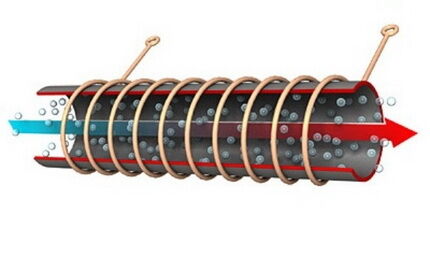
Basic elements of heating equipment
Any induction type boiler consists of several structural elements:
- Inductor. The main part of the device. It is a kind of transformer with two windings. The primary is wound on the core.When current passes, this is where an electromagnetic field arises, forming eddy currents. The boiler body acts as a secondary winding. It takes on eddy currents, heats up and transfers thermal energy to the coolant.
- A heating element. This is the coil core. For the boiler, it is made in the form of a pipe of sufficiently large diameter or several parallel-connected pipes of smaller cross-section.
- Pipes. Designed for inserting the device into the heating network. One at a time, coolant flows into the device; through the second, the liquid leaves the boiler and is supplied to the heating circuit.
- Inverter. This device - inverter — converts direct electric current into high-frequency current, which is then supplied to the inductor.
Before you begin self-assembly, you should carefully consider what and how the main elements of the device will be made of. Some of them you will have to make yourself, and some you can buy.
For example, you can use an inverter from a welding machine. It would be good if it had the ability to adjust the power.
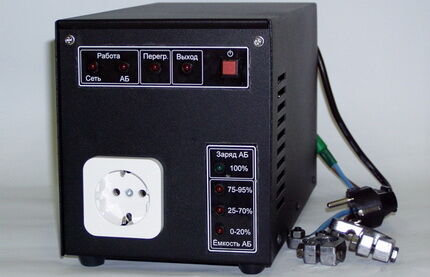
We have listed the main elements of an induction boiler.
Advantages of self-assembly of a heating device
Boilers powered by electricity are traditionally considered uneconomical. Considering that the cost of electricity is constantly rising, they cost their owners a pretty penny. We recommend looking at detailed information about heating from an electric boiler in this article.
However, induction boilers, although they run on electricity, are quite economical.
But this is not the whole list of their advantages.
By deciding to install such a device, you can get:
- Fast heating of the coolant. This takes on average 3-5 minutes.
- Efficiency is close to 100%, since almost all electrical energy is converted into heat.
- High temperature of liquid heating in the heating circuit, minimum – 35 °C.
- Lack of scale on the internal surfaces of the device, which is explained by the vibrations that occur during operation of the device. They prevent the formation of deposits.
- Long service life, since there are no moving or rubbing mechanisms and parts. Accordingly, there is no wear and tear on the equipment and no damage to its components.
- There is no need to remove combustion products and carry out frequent maintenance activities.
There are not many disadvantages of induction boilers. First of all, this is the fairly high cost of the equipment. In addition, the devices produce a slight vibration noise during operation.
Another disadvantage is the rather large mass, which must be taken into account when mounting the device on the wall.
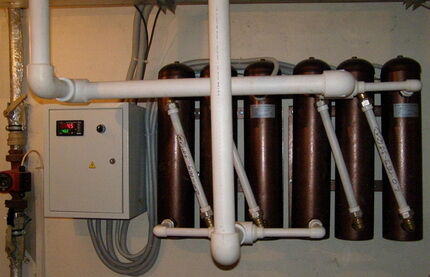
Induction boiler assembly instructions
Induction heating devices can be purchased at the store, but their cost is quite high. Therefore, many home craftsmen try to make it with their own hands. To make a homemade induction boiler, you need to prepare materials and tools.
First you need to purchase a welding inverter. It can be inexpensive, but it is advisable that the device be equipped with a current regulator.
In addition, you should pay attention to the current strength with which the device operates. The standard value for welding inverters is 15A. This won't be enough. You need to look for a more powerful unit.
In addition, you need to prepare a rod or stainless steel wire with a diameter of 7 mm or so. It should be cut into fragments 40-50 mm long. They will be placed in an electromagnetic field, where they will heat up.
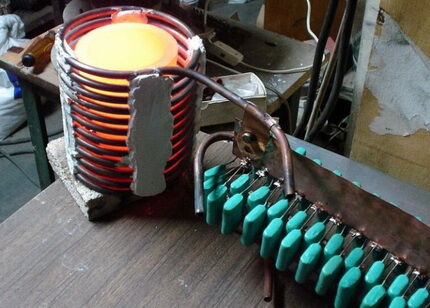
To make the boiler body, a thick-walled plastic pipe is taken. The diameter of the part may vary, but, as practice shows, the optimal option is 50 mm in internal diameter.
Adapters are used to connect equipment to the heating system. Through one of them, cold coolant will flow into the boiler, and through the other, hot liquid will be supplied to the system.
The wire fragments must be placed in the housing. To prevent them from falling out, the bottom of the part is covered with a fine-mesh metal or nylon mesh, which is securely attached to the body. After this, you can lay the wire inside the housing.
Now the upper part of the part is covered with the same mesh as the bottom, and it is secured to the walls of the part. Adapters are put on the ends. The result is a blank from which the induction coil will be made.
To do this, you need to wind an enameled copper wire around it. On average, you need to apply 90 turns. They should be located closer to the center of the part. They need to be done very carefully and evenly, so that you get a high-quality induction coil.
The resulting device can be installed in a heating system. This is done as follows. First, the coolant is drained from the system.
After this, the location where the boiler will be installed is selected. The pipe in this area is marked, after which a fragment is cut out of it, equal in length to the heating device.
Then a homemade induction boiler is installed in the prepared place. The coil is connected to the inverter, and the installation can be considered complete. After this, the system again filled with coolant.
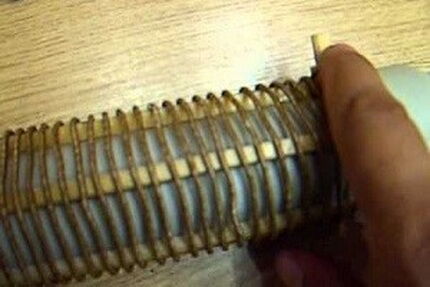
Only after this can you test the new device. There must be liquid in it.
If you turn on the induction boiler “dry”, the plastic casing will melt from the high temperature. This will lead to partial destruction of the heating system, which is unacceptable.
Another important point is the proper arrangement of grounding of the heating device, without which its safe operation is impossible.
Features of Vortex Induction Boiler
We are already familiar with the operating principle of an induction heating device. There is a variation of it: a vortex induction boiler or VIN, which operates somewhat differently.
Distinctive features of VIN
Like its induction counterpart, it operates on high-frequency voltage, so it must be equipped with an inverter. The peculiarity of the VIN device is that it does not have a secondary winding.
Its role is performed by all metal parts of the device. They are necessarily made from materials that exhibit ferromagnetic properties. Thus, when current is applied to the primary winding of the device, the electromagnetic field strength increases sharply.
It, in turn, generates a current, the strength of which rapidly increases. Eddy currents provoke magnetization reversal, as a result of which all ferromagnetic surfaces heat up very quickly, almost instantly.
Vortex devices are quite compact, but due to the use of metal, their weight is high. This has the added advantage that all massive elements of the housing take part in the heat exchange. Thus, the efficiency of the unit approaches 100%.
This feature of the device must be taken into account if you decide to make a VIN boiler yourself. It can only be made of metal, plastic should not be used.
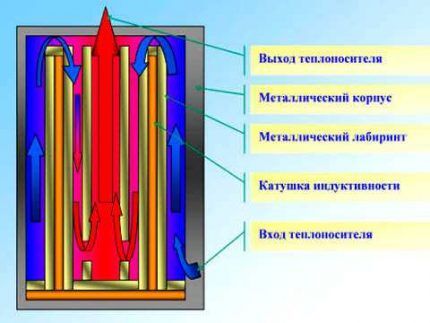
How to assemble a vortex induction device?
As we already know, such a boiler differs from its induction counterpart, however, making it yourself is just as easy. True, now you will need welding skills, because the device must be assembled only from metal parts.
To work you will need:
- Two pieces of thick-walled metal pipe of equal length. Their diameters must be different, so that one part can be placed inside another.
- Winding (enameled) copper wire.
- Three-phase inverter, maybe from a welding machine, but as powerful as possible.
- Casing for thermal insulation of the boiler.
Now you can get to work. We start by making the body of the future boiler. We take a larger diameter pipe and insert the second part inside. They need to be welded one into the other so that there is some distance between the walls of the elements.
The resulting part in cross-section will resemble a steering wheel. A steel sheet with a thickness of at least 5 mm is used as the base and cover of the housing.
The result is a hollow cylindrical tank. Now you need to cut into its walls the pipes for supplying cold and discharging hot liquid. The configuration of the pipe and its diameter depend on the pipes of the heating system; additional adapters may be needed.
After this, you can start winding the wire. It is carefully wound onto the boiler body under sufficient tension.
Actually, the wound wire will serve as the heating element, so it is advisable to cover the body of the device with a heat-insulating casing. This way it will be possible to retain maximum heat and, accordingly, increase the efficiency of the device and make it safe.
Now you need to connect the boiler to the heating system. To do this, the coolant is drained, the required length of the pipe is cut off and the device is welded in its place.
All that remains is to power the heating device and do not forget to connect the inverter to it. The device is ready for use. But before testing, you need to fill the line with coolant.
You don't know which coolant to choose to fill the circuit? We recommend that you read characteristics of various coolants and recommendations for choosing the optimal type of fluid for the heating circuit.
Only after pumping coolant into the system carry out a test run.
First you need to run the device at minimum power and carefully monitor the quality of the welds. If everything is in order, we increase the power to maximum.
On our website there is another instruction for making an induction device that can be used to heat the coolant in the heating system. To familiarize yourself with the process of assembling an induction heater, go to this link.
Unusual model of induction device
This modification of the induction boiler may seem very unusual, however, it has a right to exist.
Moreover, practice shows that such a device is much more economical than a standard heating element boiler. Heating a standard three-ruble note will take about 1.8-2.5 kW per hour, while an electric boiler will spend at least 6 kW.

Actually, the boiler is a heat exchanger embedded in the heating system, which is heated by an induction electric stove.
An important link in the design is the heat exchanger; it must be compact, reliable and as cheap as possible. Calculations show that to heat an apartment of about 50 square meters. m, a device operating with 40 liters of coolant will be sufficient.
That is, you will need a flat metal tank, the dimensions of which vary between 50x600x500 mm. It is quite possible to make such a container yourself by welding it from 50x50 profile pipes.
The work is performed in the following sequence:
- The 50x50 pipe is cut into pieces 600 mm long. There should be 9-10 pieces in total.
- The resulting sections are welded one to another according to the “wall to wall” principle so that a continuous row of pipes is obtained.
- Two more sections are cut from the pipe so that their length is equal to the width of the resulting workpiece.
- One wall is cut off from both resulting pipe fragments.
- The part is installed with the cut part on the pipes welded together so that a blank resembling a manifold is obtained. The fragment is welded to the heat exchanger.
- The second section of pipe is installed in the same way on the opposite side.
- Nozzles are welded into diagonally opposite sections of the heat exchanger for connection to the heating system.
- The structure is carefully scalded, as it must be completely sealed.
The heat exchanger is ready, it can be installed in place and a heat source can be supplied under it. Practice shows that it is best to install such a system in a bathroom using vertical installation.
The heat exchanger is welded into the heating system, and the tile is located between it and the wall.
Home craftsmen claim that if you connect an inverter to such a device, its energy consumption will be significantly reduced.
After reading the instructions, does making homemade boilers seem difficult and dangerous to you? Do you doubt that a homemade product will be more economical in using electricity to heat the coolant in the heating system? In this case, purchasing a ready-made heating unit will be the best solution.
Our website contains useful materials on choosing the best electric boiler and a rating of the most popular models among buyers. We also recommend that you familiarize yourself with the features of calculating energy consumption by a boiler and other options for electric heating in the house:
- Electric boiler for heating a private home: review of the top ten models of electric boilers
- How much electricity does an electric boiler consume: calculation rules
- Electric heating in a private house: overview of types of systems for a country house
Conclusions and useful video on the topic
How to assemble an induction type boiler yourself:
How a homemade induction heater works:
What is induction heating:
An induction boiler is the most economical and efficient of all heating devices powered by electricity. There are many modifications of homemade induction devices; you can choose any that is most suitable for operating conditions.
To buy such a device in a store you will have to spend a significant amount, so home craftsmen have learned to make them themselves.
Do you use a homemade induction boiler as a heating device? Share a photo of your homemade product and assembly instructions in the comments section.
Or maybe you are just about to start making a boiler and you still have unresolved questions after reading our article? Don't hesitate to ask them - we will try to help you.
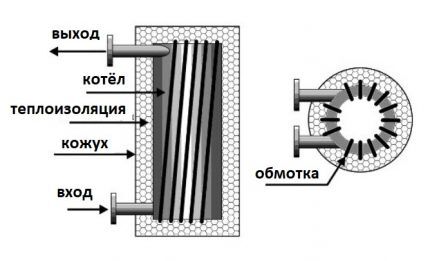





To be honest, the feasibility of self-assembling an induction boiler looks doubtful. The price will be not much cheaper than budget Chinese, and even domestic ones. And the effectiveness of such a homemade product performed by an inexperienced person will be questionable.
Agree. Moreover, if there were doubts only in terms of efficiency, the safety of such devices is also in question. I would be wary of living next door to such a homemade induction heating boiler.
Hello, I am a radio amateur on the Internet, I looked at all sorts of different induction heater circuits and decided to assemble one of the circuits on irfp260 at 24 volts and it works perfectly. Then I decided to assemble an induction boiler on a welding inverter. I need the help of professionals. I have a greenhouse 20 m by 10 m 200 kV .meters, I decided to install a radiator with a fan from an air conditioner instead of a battery with a homemade induction boiler, this is how it will maintain heat